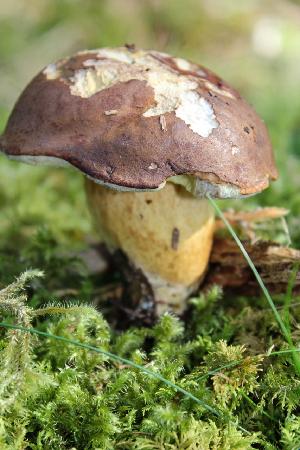
Within the framework of the Mycorrhizal Genomics Initiative
(MGI), we are sequencing a phylogenetically and ecologically
diverse suite of mycorrhizal fungi, which include the major clades
of symbiotic species associating with plants. Analyses of these
genomes will provide insights into the diversity of mechanisms for
the mycorrhizal symbiosis, including arbuscular, ericoid-, orchid-
and ectomycorrhizal associations.
The Bay Bolet Xerocomus badius
The porcini Xerocomus badius (Fr.) Kühn. syn.
Boletus badius Fr., commonly known as the bay bolete, is a
conspicuous wild, edible mushroom characterized by fleshy fruiting
bodies with a poroid hymenophore. It is found on the ground or on
decaying tree stumps in coniferous or mixed forests of Europe and
North America. Although the bay bolete is predominantly an
ectomycorrhizal mutualist, it is thought to have some saprobic
abilities.
Genetic analysis published in 2013 shows that Xerocomus (Boletus) badius is taxonomically-related to B. pallidus and B. glabellus; the three species form a clade known informally as the badius clade in the suborder Boletineae. A molecular clock analysis dates the origin of porcini to between 42 and 54 million years ago, coinciding with the initial diversification of angiosperms, during the Eocene epoch when the climate was warm and humid.
Several genomes of saprotrophic and ectomycorrhizal Boletales
have been produced by the MGI, including Boletus edulis,
Suillus luteus, Gyrodon lividus, Paxillus
involutus, P. rubicundulus and Coniophora
puteana. The genome of Xerocomus badius will provide
glimpse into the Boletales evolution.
The MGI is a large collaborative effort led by Francis Martin
(INRA) aiming for master publication(s) describing the evolution of
the mycorrhizal symbioses. Researchers who wish to publish analyses
using data from unpublished MGI genomes are respectfully required
to contact the PIs and JGI to avoid potential conflicts on data use
and coordinate other publications with the MGI master paper(s).
Genome Reference(s)
Miyauchi S, Kiss E, Kuo A, Drula E, Kohler A, Sánchez-García M, Morin E, Andreopoulos B, Barry KW, Bonito G, Buée M, Carver A, Chen C, Cichocki N, Clum A, Culley D, Crous PW, Fauchery L, Girlanda M, Hayes RD, Kéri Z, LaButti K, Lipzen A, Lombard V, Magnuson J, Maillard F, Murat C, Nolan M, Ohm RA, Pangilinan J, Pereira MF, Perotto S, Peter M, Pfister S, Riley R, Sitrit Y, Stielow JB, Szöllősi G, Žifčáková L, Štursová M, Spatafora JW, Tedersoo L, Vaario LM, Yamada A, Yan M, Wang P, Xu J, Bruns T, Baldrian P, Vilgalys R, Dunand C, Henrissat B, Grigoriev IV, Hibbett D, Nagy LG, Martin FM
Large-scale genome sequencing of mycorrhizal fungi provides insights into the early evolution of symbiotic traits.
Nat Commun. 2020 Oct 12;11(1):5125. doi: 10.1038/s41467-020-18795-w
